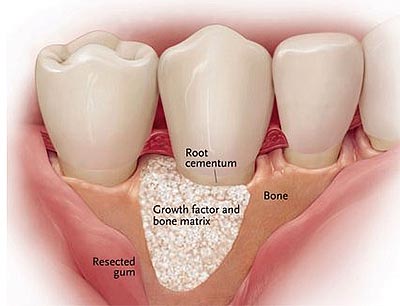As we get older, we’re more likely to experience gum disease, which in turn can lead to bone loss. If that’s the case, bone regeneration is often necessary to prevent tooth loss or prepare your jawbone for dental implants.
What Is Bone Regeneration?
In the early stages of gum disease, your dentist may use a non-surgical gum disease treatment such as scaling and root planing to remove dental tartar and infection below the gum line and smooth the area so the tissues can repair themselves. When bone is lost, the hard tissue will not be able to repair itself on its own, making non-surgical periodontal procedures ineffective.
Bone regeneration is a periodontal surgical procedure that regenerates jaw bone and tissue to correct the damage caused by periodontal disease. Bone regeneration is often performed to protect your existing teeth and the soft tissues that keep them in place.
Bone regeneration can also benefit patients with missing teeth and those who don’t qualify for dental implants. While a dental bridge or dentures can help slow down the process, they will not eliminate the bone loss that inevitably occurs from tooth loss. Although dental implants resolve this problem, they require a significant amount of jawbone prior to the procedure in order to be successful. Bone regeneration can help patients who suffer from a deteriorated jawbone support their restorations or prepare for the implant dentistry procedure.
How Does Bone Regeneration Work?
First, your dentist or periodontist will remove any dental plaque or dental tartar found beneath the gum line. Biocompatible membranes are then placed between the bone and gums, which acts as a barrier between the two. This barrier prevents the gums from growing into the bone tissue as it heals and also encourages new bone to grow.
There are two types of bone regeneration used to treat advanced stages of gum disease:
Guided Bone Regeneration (GBR)
— The procedure described above is often used to regenerate bone to support a fake tooth, such as a dental bridge or dental implant. GBR is also used to save teeth from being lost.
What is the Success of Bone Regeneration?
The success rate of bone regeneration varies depending on your health condition, the amount of bone lost and the type of materials used — of course, the earlier you have this dental treatment the better. It’s also important to follow your dentist’s post-treatment guidelines to increase your chances of a successful procedure and help prevent bone loss from recurring.
Remember, gum disease can’t be cured — but it can be treated. If you’re one of the millions of Americans who suffer from periodontal disease, take the right measures to prevent bone and tooth loss. Practicing excellent oral hygiene and visiting your dentist regularly not only benefits your oral health but contributes to your overall health as well. So for better health, take care of your teeth and gums.
These procedures are different from bone grafting, a surgical procedure that uses bone from another area of the body or a synthetic substance to replace missing bone. The graft strengthens the area by forming a bridge between itself and the existing bone. If the bone graft is successful, the replacement bone will fuse to your natural jawbone, allowing the natural bone to grow and eventually replace most of the grafted material. Many dentists use bone grafting in combination with bone regeneration for optimal effect.

